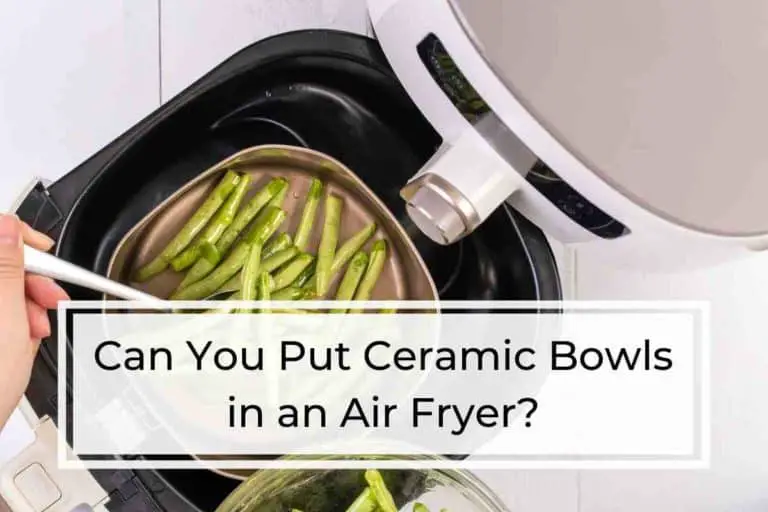How Safe Are Soup Bowls in the Oven?
Soup is a staple on dinner tables, especially in winter. Although the correct material to use for cooking and serving soups can be tricky, you should read the manual before using bowls that are not oven-safe to avoid ruining your bowl, oven, and food.
How Safe Are Soup Bowls in the Oven?
Ceramic, porcelain, tempered glass, pyrex glass, and stoneware soup bowls are generally oven-safe. In contrast, plastic, melamine, bone china, and metal are not safe to use in the oven. However, you should always check the oven-safe label before using any kitchenware in the oven or microwave.
The following information will help you understand the factors to consider when using a soup bowl in an oven. Furthermore, you will learn about different bowls based on their materials and shapes. In addition, you will know the average size of a soup bowl.

If you are interested in the best bowls and bowl sets, be sure to visit my Recommended Products Page (click to see my page) which includes all of my top picks by category.
Can Ceramic Soup Bowls Go in the Oven?
The ceramic and ceramic coated bowls are safe to use in the oven. The ceramic bowls made of clay are placed in the fire to harden, making them heat resistant. On the other hand, you have to check if ceramic-coated bowls are oven-safe or not, as some metals can warp when heated at high temperatures.
In addition, the unglazed bowls can also be sensitive to temperature changes when you put a room temperature or cold bowl in a preheated oven. Therefore, you should always put your bowls in the oven while heating them to prevent damage.
Read Also: What Bowls Are Safe for the Double Boiler?
What Type of Soup Bowls Can Go in the Oven?
Ceramics, glass, stoneware, and porcelain soup bowls can usually go in the oven or microwave. However, you should always check the oven-proof label and temperature before using any utensils in it. Furthermore, bowls made of plastic, fine china, metal, bone china, bamboo, and melamine are not oven-safe.
Always make sure if bowls are oven-safe or not by checking the tag or manual guide. You can also check that on the official website of the manufacturer company. If it is not marked oven-safe, you should try not to use it in the oven and microwave.
It is, however, not recommended to place the soup bowl in the oven while the oven is heating up to avoid any damage due to a temperature change. Even though the bowl is oven safe or not, it can be damaged if you take it from one extreme temperature to another.
Read Also: Are Cereal Bowls Oven Safe?
What Are Soup Bowls Made Of?
Below are brief descriptions of the different types of soup bowls based on the materials they are composed of and the manufacturing process:
Ceramic Bowls
The ceramic conducts heat evenly, and the ceramic bowls are the most widely used. These bowls are very aesthetically pleasing, and your food looks more appealing in them.
Plastic Bowls
The plastic bowls are cheap, durable, and very popular among people. However, they are typically not oven-safe because, when you heat them, there is a higher risk of leaching chemicals into your food, making it unhealthy.
Glass Bowls
Glass bowls are beautiful but fragile, so you need to handle them carefully when serving soup to kids. However, the glass bowls are usually oven-proof, but you must wash them by hand.
Porcelain Bowls
These bowls are translucent and white and made from refined clay used to manufacture them that is fired at high temperatures ranging from 1200 to 1450 degrees Celsius and comes out as a solid and shiny material.
Metal Bowls
The soup bowls made of metals are usually not recommended to use in the oven because they can get hot and cause a burn, but if you use a bowl with a plate to serve soup.
Fine China Bowls
These bowls are fragile and intended for only display purposes rather than serving food. They need to be cleaned and washed by hand, and also they are not oven and dishwasher safe.
Bone China Bowls
The bone china bowls consist partly of real bones of animals that were burned to make ash that then used to form a paste-like mixture to make these bowls. They are thinner than fine china and more durable but still need care.
Bamboo bowls
Bamboo bowls have been in demand in recent years because they are sustainable and eco-friendly. Therefore, they are the best option for environmentally conscious people. Further, they need to wash by hand and are not microwave safe.
Stoneware Bowls
The clay used to make stoneware bowls is fired at 1200 degrees Celsius to make them durable, waterproof, and perfect for everyday use without glazing. They are attractive, colorful, and microwave-safe.
Melamine bowls
Melamine bowls are a lot like plastic but very different and attractive. These bowls are cheap and popular among kids as they are fun and easy to use.

What Are the Types of Soup Bowls Based on Shapes?
There are seven types of soup bowls available according to their shape, which we discuss below:
- Soup plates are large and flat, and they are perfect for serving formal meals.
- Covered Soup Bowl: It is easy to transfer the soup from the kitchen to the table with a covered soup bowl since they have a lid.
- Bouillon cups are also called broth bowls and resemble mugs.
- Lug soup bowls are oven-safe and used for french onion or similar soups.
- Coupe soup bowls are perfect for informal meals.
- Cereal soup bowls are smaller; than soup plates and coup bowls and are used for a more informal dish.
Cream soup bowls are suitable for cream soups at light meals.
Read Also: Can You Marinate Meat In A Stainless Steel Bowl?
What Size Soup Bowl Is Best?
The average size of a soup bowl is 8-12 and 4 ounces for a soup cup. As the soup is a part of the meal and not the entire thing so smaller sizes are preferable, but the size of the soup bowl depends on different factors such as
- The type of soup that the bowl will hold
- The serving size, so the bowl does not look grossly oversized or overfilled
- when soup or soup with bread, etc.
Conclusion
There are different types and sizes of soup bowls available on the market based on the requirements of each person. Nonetheless, always refer to the manual, the bowl boxes, or the manufacturer’s website before placing them in the microwave.
If you are interested in the best bowls and bowl sets, be sure to visit my Recommended Products Page (click to see my page) which includes all of my top picks by category.






